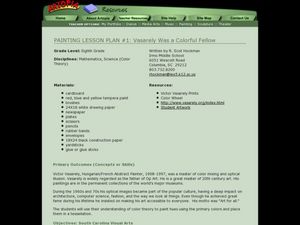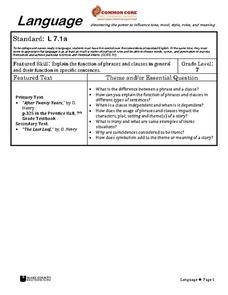Curated OER
Seeing is Believing - Or Is It?
Here is a great science instructional activity. It extends the concept of vision into the area of optical illusions, perspective, and tessellation. This well-designed plan has tons of great activities, utilizes interesting video, and...
Curated OER
Applied Science - Science and Math Post-Lab
Students explore optical illusions. In this Applied Science instructional activity, students view optical illusions and record the data of what they see. Students graph the data that they collect.
Curated OER
Light, Colors, and Vision
Third graders experience optic illusions by creating flipbooks. In this optics lesson, 3rd graders view a demonstration of the workings of rods and cones using a camera. They are shown an optical illusion and work to create their own...
Curated OER
Optical Illusion
Students practice creating optical illusions as well as discerning how perception of information may change its characteristics. They distinguish between an equilateral triangle, endpoints, vertices's, and segments of triangles. The...
University of Minnesota
Beautiful Brain: Do You See What I See?
Can art play tricks on your eyes, and can a still painting really appear to vibrate? The second lesson in a four-part series discusses the way our beautiful brains translate visual images. It highlights the style of optical art and...
Curated OER
The Components of Light
Students are given a mnemonic device to review the light spectrum as it relates to the different components of refracted light. In this components of light lesson, students read Light Magic and review the properties of light. Students...
Scholastic
Optical Illusion
Number theory gets a workout in an activity that asks individuals to identify and color code the prime numbers and the composite numbers in the provided graphic.
National Gallery of Canada
My Upside-Down World!
M.C. Escher is famous for creating optical illusions. Examine this effect in several of his works and discuss the techniques involved. Inspired by the discussion, learners create an imaginary 3-D world inside of a box using various...
Curated OER
Vasarely Was A Colorful Fellow
Eighth graders create artwork inspired by the work of Victor Vasarely. In this op art lesson, 8th graders explore color theory and color mixing. Students create ten shapes to use in their artwork and over the course of two weeks,...
Wake County Public Schools
Language
Have your class doing everything from reading literature, analyzing literary devices, identifying independent and dependent clauses, discussing, and writing creatively with the rich resource found here. After a mini lesson on independent...
LABScI
Vision Lab: The Eye
Our bodies have some amazing capabilities, but there are some limitations. Explore the limitations of the human eye through the eighth lab activity in a series of 12 biology lessons. Individuals measure their own peripheral vision and...
University of Minnesota
Welcome To Your Senses
Sound, sight, taste, touch, and smell—oh the world of senses! What do these five senses have to do with the brain? The answer: everything. Explore how the brain sends and receives messages by having the class participate in several sense...
Curated OER
Would You Believe Your Eyes?
Students study the parts and functions of the human eye. They create dodecagons which are twelve-sided figures with twelve equal angles and share these with the class so that each student can begin to see how many different illusions can...
Curated OER
Op Art and Contrast
Seventh graders create Op art designs by reading web information through FlingIt, mapping learned concepts with PicoMap, and creating how-to examples of their own Op art design by using Sketchy. They complete the lesson by creating their...
Curated OER
Perception and the Brain
Students experience how the brain adapts over time to changes in what they perceive. In this human perception lesson, students wear special prism goggles that initially disorient the user. Over time, the student is able to adjust to the...
Curated OER
Vision Of The Future
Students investigate ways in which new vision tests and technologies can be used to help detect and correct vision problems. They begin by reading the Times article, Software May Replace the Eye Chart on the Wall. They stage a medical...
Curated OER
Stations of Light
Student groups rotate through four stations to examine light energy behavior: refraction, magnification, prisms and polarization. They see how a beam of light is refracted (bent) through various transparent mediums. Students investigate...
Curated OER
The Five Senses
Students recognize how each of the five senses works and define the related terminology. They compare and contrast the means by which the senses gather information about the world. In addition, they research how an assigned sense works...
Curated OER
Does Negative Space Have A Shape?
Students observe negative space in drawing. In this negative space lesson, students discover that sketches include negative space or background. Students produce a drawing while paying attention to the negative space.
Curated OER
Reflection, Refraction & Lenses
Students are able to describe what happens to light when it strikes different materials. They describe the law of reflection. Students are able to explain why a mirror froms a virtual image. They are able to describe diffuse reflection.
Other popular searches
- Printable Optical Illusions
- Optical Illusions Art
- Geometry Optical Illusions
- Math Optical Illusions
- Science Optical Illusions
- Optical Illusions Designs
- Optical Illusions Bird Cage
- Fractions Optical Illusions





















